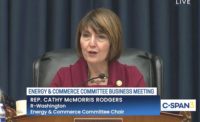America’s conflicted relationship with nuclear energy is back at center stage, and ENR Energy’s lead story explores it this month. Nuclear energy generates huge quantities of power without carbon-dioxide emissions; that’s good. Nuclear plant construction costs and schedules have grown to gargantuan proportions; that’s shocking. Nuclear power plants have suffered spectacular, environment-damaging failures in Chernobyl and Fukushima Daiichi; that’s scary. Spent nuclear fuel is stored at dozens of sites around the country because we can’t agree on a permanent waste repository; that’s politics. And, since 2012, operating costs have made nuclear power plants increasingly uncompetitive with wind and solar energy; that’s economics, and it’s causing utilities to shut down nuclear plants at a rate that is beginning to prompt alarm.
Each of these factors has prevailed in public perceptions of nuclear power at different times. In the 1980s, orders were canceled when ballooning construction costs and schedules and fears triggered by the Three-Mile Island meltdown cooled enthusiasm. As concern about global warming driven primarily by human activities rose in the early 2000s, nuclear’s carbon-free generation trumped safety concerns and led the nuclear industry to proclaim “nuclear renaissance.” Today, torn between fears prompted by the Chernobyl and Fukushima disasters and the urgent need for carbon-free power, and governed by a Congress that is paralyzed and divided by ideology, the country waits for the saga’s next development, unsure whether we will want it when it occurs.
Our ambivalence about nuclear energy is rooted deep in our history. “I think the Dept. of Energy commitment [to nuclear energy] is political and ideological,” says Arjun Makhijani, president of the Institute for Energy and Environmental Research, Takoma Park, Md. Makhijani traces that commitment back to Pres. Eisenhower’s 1953 “Atoms for Peace” speech to the United Nations, which was intended to assuage Cold War fears of a horrifying military technology by highlighting its potential benefits and civilian applications. Construction began less than a year later on the Shippingport Atomic Power Station in Pennsylvania, the nation’s first commercial nuclear plant, and the reactor reached criticality in 1957. The civilian application was realized, but the fear was never entirely assuaged.
Probably no other U.S. nuclear plant has duplicated that construction schedule, and the capital costs of subsequent plants have been grotesquely distorted. Still, utility companies in regulated power markets, where rate-payers bear the costs, continue to propose and construct new nukes. As this month’s lead story explains, nuclear plant designs continue to evolve and manufacturers promote their safety, reliability and simplicity as the solutions to the problems of older reactors.
But can nukes, old or new-and-improved, compete economically with increasingly cheap renewable energies? Can they cost-effectively provide services other than base-load capacity in a system with substantial solar and wind installations? Or are these even the right questions to ask? Diversity of supply is the guarantee for system reliability, and for the foreseeable future we will need base-load capacity supplied by the old standbys—nuclear, fossil fuels and hydropower—to ensure reliability for a system with growing intermittent-renewable capacity. Generation technologies that can’t compete on price may have to be subsidized during the transition to a decarbonized system.
We’ll still need a permanent repository for spent fuel. Breaking that deadlock is the job of Congress and, by logical extension, of us, the voters. But who will assuage the fears?
Tom Armistead is the consulting editor of ENR Energy. After a 23-year career in construction, he served 12 years as ENR’s editor for power and industrial news and subsequently for energy news.



Post a comment to this article
Report Abusive Comment